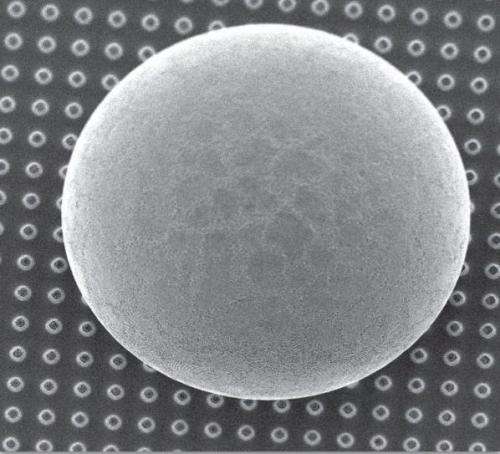Nanotechnologists create minuscule soccer balls

Nanotechnologists at the University of Twente's MESA+ research institute have developed a method whereby minuscule polystyrene spheres, automatically and under controlled conditions, form an almost perfect ball that looks suspiciously like a football, but about a thousand times smaller. The spheres organize themselves in such a way that they approach the densest arrangement possible, known as 'closest packing of spheres'. The method provides nanotechnologists with a new way of creating minuscule 3D structures.
The research was published this week in the leading scientific journal Proceedings of the National Academy of Sciences (PNAS).
The method developed by the University of Twente scientists involves placing a drop of water containing thousands of polystyrene spheres one micrometre in size (a thousand times smaller than a millimetre) on a superhydrophobic surface. As the drop is allowed to evaporate very slowly under controlled conditions the distances between the spheres become smaller and smaller and surprisingly they form a highly organized 3D structure.
The spheres were found to organize themselves of their own accord in such a way that the ball they form approaches the most compact arrangement possible ('closest packing of spheres'), with 74% of the space filled by the spheres. Like a football, the structures that form are almost perfectly spherical, consisting of a large number of planes. The researchers have therefore dubbed their material 'microscopic soccer balls'. The minuscule footballs are a hundred to a thousand micrometres in size, containing from ten thousand to as much as a billion of the tiny polystyrene spheres.
The research at Twente has produced a new method of creating complex 3D structures of this kind by means of self-assembly. As the scientists are able to precisely control the number of polystyrene spheres and the evaporation rate, they can determine the structure of the end-product with great precision. The method thus provides nanotechnologists with a new way of creating minuscule structures efficiently. They could eventually be used e.g. for medical purposes and in the food industry.
More information: Building microscopic soccer balls with evaporating colloidal fakir drops, PNAS, Published online before print September 24, 2012, doi: 10.1073/pnas.1209553109
Abstract
Evaporation-driven particle self-assembly can be used to generate three-dimensional microstructures. We present a unique method to create colloidal microstructures in which we can control the amount of particles and their packing fraction. To this end, we evaporate colloidal dispersion droplets on a special type of superhydrophobic microstructured surface, on which the droplet remains in Cassie–Baxter state during the entire evaporative process. The remainders of the droplet consist of a massive spherical cluster of the microspheres, with diameters ranging from a few tens up to several hundreds of microns. We present scaling arguments to show how the final particle packing fraction of these balls depends on the dynamics of the droplet evaporation, particle size, and number of particles in the system.
Journal information: Proceedings of the National Academy of Sciences
Provided by University of Twente


















